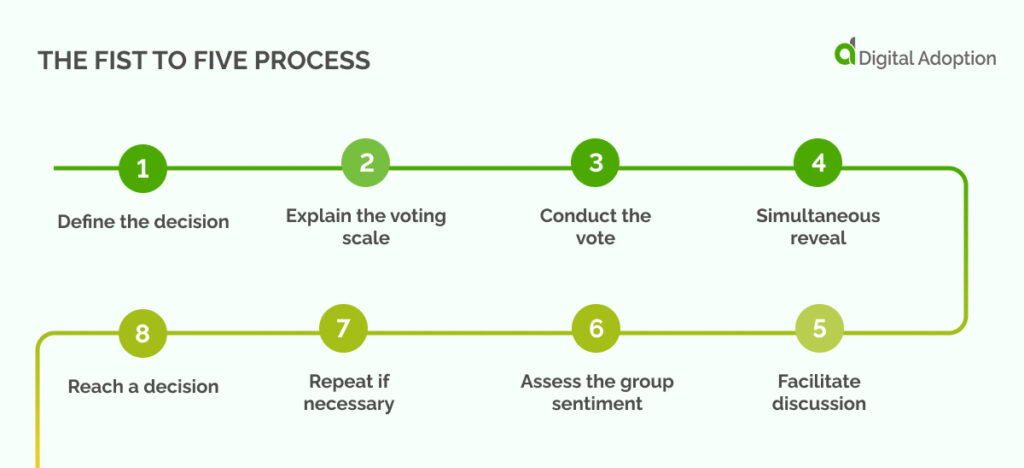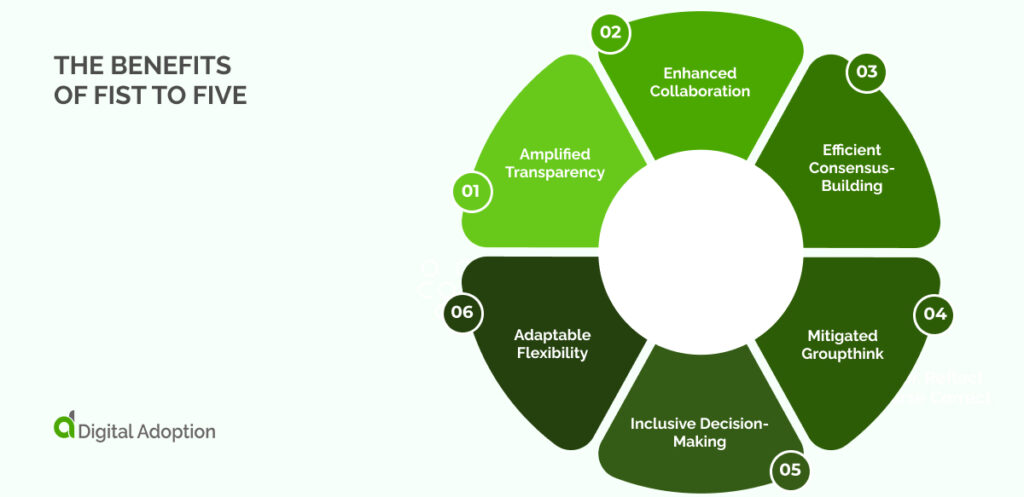Fist to five is a contemporary voting method groups and teams use to reach a consensus during decision-making.
Modern consensus-building methods, such as Fist to Five, are instrumental in driving organizational transformation and preparing teams for the future of work.
Harvard Law School states, “Consensus-building techniques can help parties facing a group decision reach longer-lasting, more harmonious outcomes than resorting to an up-or-down vote.”
In this article, we’ll explore the benefits of Fist to Five and how it can improve group dynamics and decision-making processes. We’ll also look at implementing this technique effectively within your organization.
What is Fist to Five?
Fist to Five is a participatory decision-making technique utilized by groups and teams to gauge the level of consensus or agreement on a particular proposal or idea.
Instead of the simple two-option answer of “yes” or “no,” the increasing scale of options enables a more qualitative form of gauging consensus, with the intensity of agreement increasing with the increase of each finger.
The methodology works by first posing a question or statement, of which respondents then share their level of agreement by holding up a number of fingers.
A fully closed fist represents the most non-agreeable way of answering, serving as the unequivocal “no,” with a show of five fingers representing the most agreeable answer—or simply a resounding “yes.”
The effectiveness of Fist to Five is more related to facilitating open communication and encouraging participation rather than statistical analysis or collecting numerical data.
Why Is Fist To Five Important?

With the ongoing digital transformation across sectors, consensus-building methods are vital in facilitating effective decision-making and fostering collaboration.
Navigating the complexities of group decision-making becomes significantly easier with the “Fist to Five” method.
Let’s explore why it’s important:
Promotes Engagement
Fist to five encourages active participation in discussions, ensuring everyone’s opinions are heard and valued.
Quick Feedback
It provides a fast and efficient way to gauge the comfort level, understanding, or agreement on a particular topic or decision.
Non-Verbal Communication
For those who are less vocal, it offers a non-threatening way to express their thoughts or feelings.
Encourages Consensus
It promotes a democratic decision-making process where everyone’s vote counts, fostering a sense of unity and consensus.
Easy to Use
The simplicity of the fist to five method makes it accessible and easy to adopt for any team or group, regardless of their size or diversity.
Versatile Tool
It can be used in various settings – classrooms, corporate meetings, community gatherings, etc., making it a versatile tool for feedback and decision-making.
Boosts Transparency
It encourages openness and transparency by visually displaying the level of agreement or disagreement within a group.
6 stages of Fist to Five:
When teams use simplistic “yes” and “no” voting methods, it leaves little room for conveying often nuanced and complex opinions of team members.
This five-point scale facilitates a more informative way of building consensus, better-enabling leaders to gauge the needs and expectations of their teams.
The Fist to Five Process

How to Use Fist to Five Voting Strategy in Meetings?
As previously stated, each participant extends their hand, representing their vote, with a closed fist indicating strong opposition (zero) and an open hand with all fingers extended, signifying complete support (five).
However, if respondents aren’t entirely aware of the scope of the question or the accurate meaning of each vote, it can lead to potential misunderstandings and misinterpretations of the results.
Below, we outline the Fist to Five process in eight simple steps to help facilitate effective decision-making and foster open communication within your team or group.
- Define the decision
Clearly articulate the decision or problem that needs to be addressed. Ensure that all participants have a common understanding of the issue at hand.
- Explain the voting scale
Share the Fist to Five voting scale with all participants. Emphasize that a closed fist represents strong opposition (zero), and an open hand with all fingers extended signifies complete support (five).
- Conduct the vote
Ask participants to extend their hand and cast their vote by showing a number of fingers representing their level of agreement or opposition. Participants should keep their vote hidden until everyone is ready to reveal it simultaneously.
- Simultaneous reveal
Instruct participants to reveal their votes at the same time. This ensures that individuals aren’t influenced by others and encourages an honest expression of opinion.
- Facilitate discussion
Encourage participants to explain their chosen vote and its reasoning. Foster an open and respectful discussion where participants can ask questions, seek clarification, and share perspectives
- Assess the group sentiment
Evaluate the overall sentiment of the group by observing the distribution of votes. Take note of any extreme positions or areas of consensus.
- Repeat if necessary
If consensus is not reached or further refinement is needed, conduct additional rounds of voting and discussion. This iterative process allows for exploring alternative options and gathering more feedback.
- Reach a decision
Based on the discussion and feedback received, work towards reaching a decision that considers all participants’ input. Aim for a solution that garners a reasonable level of agreement and addresses the concerns raised during the process.
What Are The Benefits of Fist to Five?

According to the Office of Personnel Management (OPM), effective teams strive for consensus, which means finding a proposal acceptable enough that all team members can support it, with no member opposing it.
Introducing the Fist to Five methodology into your decision-making process assists in this regard, expediting consensus building along with an array of other remarkable benefits.
Here’s a glimpse into the advantages that await:
- Amplified Transparency
With Fist to Five, transparency takes center stage. Each participant openly displays their level of agreement or dissent on a scale from one to five. This fosters a culture of honesty, ensuring that all viewpoints are acknowledged and respected.
- Enhanced Collaboration
By encouraging everyone to voice their opinions, Fist to Five cultivates a collaborative environment. Team members engage in active discussions, exchanging ideas and perspectives, leading to comprehensive decision-making incorporating diverse insights.
- Efficient Consensus-Building
Fist to Five streamlines the consensus-building process by promoting quick assessments of agreement. Rather than prolonged deliberations, this method allows teams to swiftly gauge collective sentiment, saving time and expediting progress.
- Mitigated Groupthink
The Fist to Five approach safeguards against the pitfalls of groupthink. Encouraging individuals to evaluate their level of support independently mitigates the influence of dominant voices and promotes critical thinking among team members.
- Inclusive Decision-Making
Every participant’s opinion holds value in Fist to Five. It ensures that all team members, regardless of seniority or hierarchy, have an equal opportunity to contribute. This inclusivity fosters a sense of ownership and boosts overall morale within the team.
- Adaptable Flexibility
Fist to Five enables adaptability by allowing participants to signal their readiness for change. The scale clearly indicates individuals’ willingness to embrace new ideas, facilitating agility in decision-making and adapting to evolving circumstances.
How to implement Fist to Five successfully
To successfully implement Fist to Five, certain prerequisites and organizational requirements should be considered.
Understanding organizational change adoption is vital, as it allows the method to be tailored to specific needs and dynamics. This includes creating an environment where collaboration and consensus-building are encouraged and where the input of all team members is valued.
A unified communication solution also plays a critical role in the successful implementation of Fist to Five. Team members must be aware of the importance of strong consensus building and understand how their active participation can contribute to better decision-making.
Clear communication channels should be established to facilitate open dialogue and ensure that concerns and ideas are effectively shared and addressed.
In situations where voters’ concerns are unmet, it is essential to have mechanisms to remedy the situation. This may involve revisiting the proposal, engaging in further discussion and negotiation, or exploring alternative solutions that accommodate the team’s needs.
Additionally, if a deadlock is reached where a consensus cannot be achieved, the option of conducting another vote can be exercised. This allows for a reassessment of the proposal and allows one to consider fresh perspectives and potential alternatives.
This approach values and integrates diverse perspectives, ensuring that decisions are well-rounded, comprehensive, and reflective of the team’s collective wisdom.
Fist to Five – A Qualitative Approach to Consensus Voting
When it comes to consensus voting, the qualitative approach offered by methods like Fist to Five proves to be superior and more advanced compared to quantitative voting methods.
Traditional quantitative voting methods, based solely on numerical calculations or majority rule, often overlook the diverse range of perspectives and ideas within a team. This can lead to decisions that lack depth, fail to address critical concerns, and hamper the organization’s overall progress.
In contrast, Fist to Five allows team members to express their level of agreement or disagreement on a spectrum, enabling a more comprehensive understanding of the group’s sentiment and facilitating meaningful discussions.
Smooth team dynamics are essential in any organization, particularly in the era of digital transformation where agility is the key to driving business value.
By emphasizing the importance of open communication, nuanced perspectives, and effective collaboration, Fist to Five enables teams to make better-informed decisions and cultivate a culture of inclusivity and adaptability.
Fist to Five FAQs
Q: Is 100% consensus necessary in Fist to Five voting?
A: No, 100% consensus is not required in Fist to Five voting. The goal is to reach a general sense of agreement or support within the team rather than requiring unanimous agreement.
Q: Can we use fractional votes in Fist to Five voting?
A: Yes, fractional votes like 3.5 or 4.5 can be used in Fist to Five voting to represent a moderate level of support or opposition, indicating that someone is leaning towards a particular position but not fully committed.
Q: How is the final decision made in Fist to Five voting?
A: The final decision in Fist to Five voting depends on the level of agreement among team members. The facilitator may use the vote tally as input for further discussion or negotiation to strive for a resolution that satisfies most team members.









